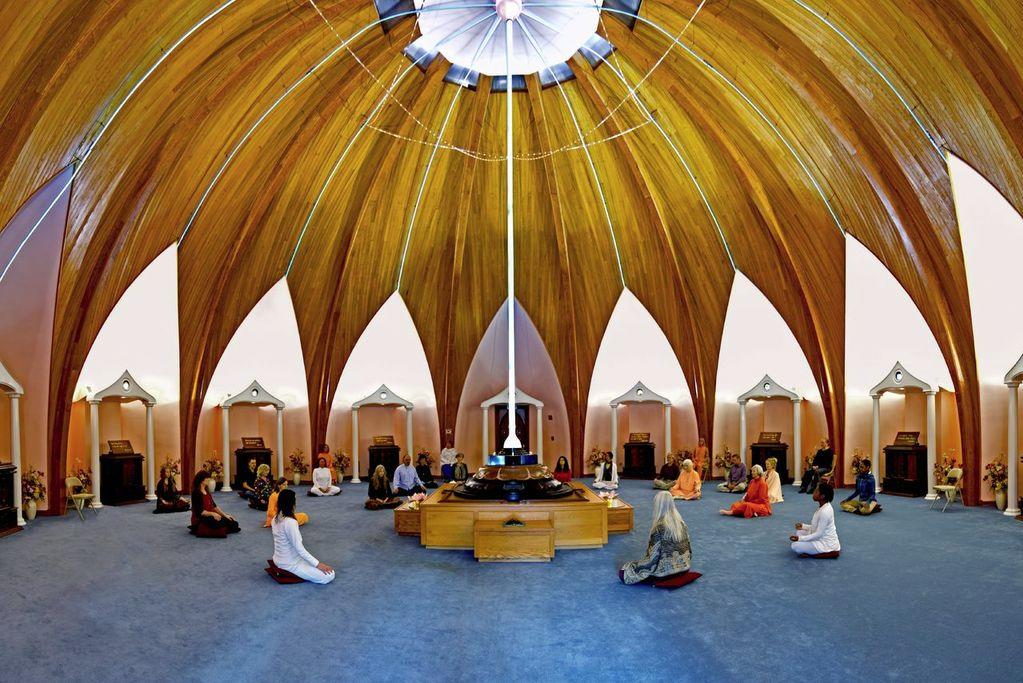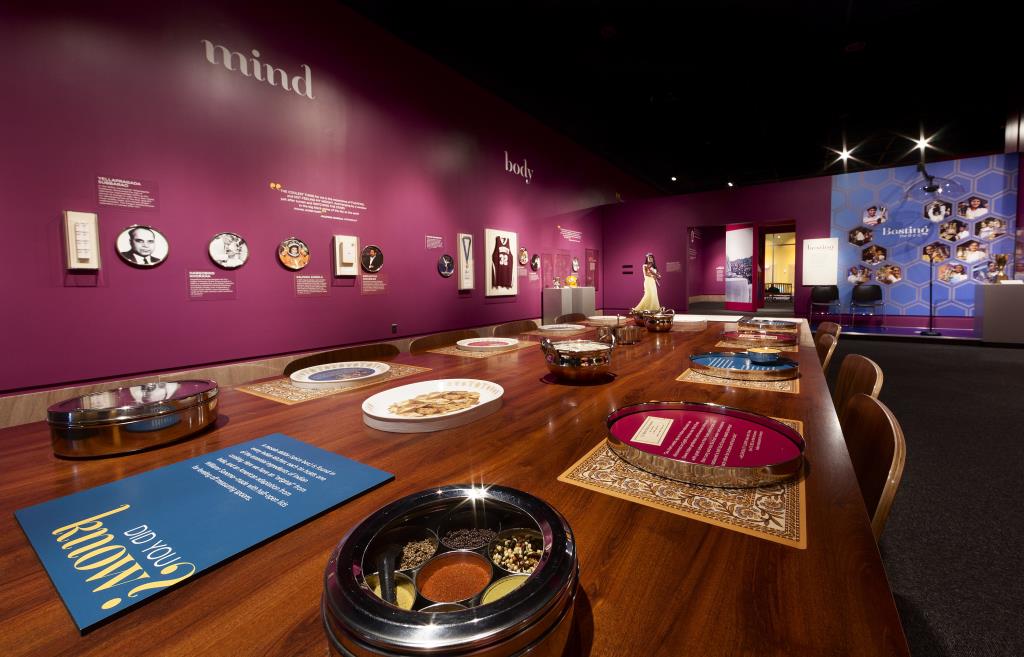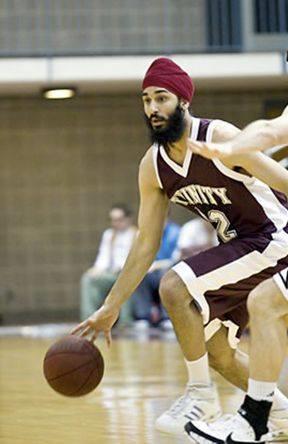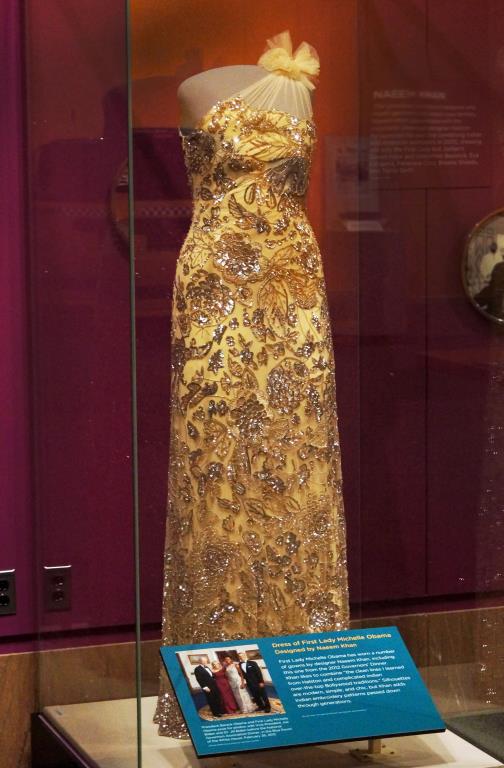April 2, 2014
By Geeta Goindi
Washington, DC – Smithsonian Institution’s new exhibition, ‘Beyond Bollywood: Indian-Americans Shape the Nation’, is an emotional encounter for the Indian diaspora here, and a learning experience for everyone!

April 2, 2014
By Geeta Goindi
Washington, DC – Smithsonian Institution’s new exhibition, ‘Beyond Bollywood: Indian-Americans Shape the Nation’, is an emotional encounter for the Indian diaspora here, and a learning experience for everyone!

The Lotus Upper Shrine at the Yogaville Ashram in Buckingham, Virginia, on display in the Smithsonian exhibition, ‘Beyond Bollywood: Indian-Americans Shape the Nation’, at the National Museum of Natural History
On view at the National Museum of Natural History until August 16, 2015, it takes visitors on a fascinating journey into the lives of early immigrants all the way up to present-day residents. And all Indian-Americans are represented. With meticulousness, the exhibition elucidates their triumphs, trials and tribulations!
Considerable credit for the comprehensive display, in a 5,000 square-feet space on the second floor of the gallery, goes to the Curator, Dr. Masum Momaya, an Indian-American who grew up in Chicago. Speaking to INDIA THIS WEEK about the relevance of the exhibition, she said, “The contributions of various Asian American communities to American history are still not widely known. I think most people would be surprised to learn that our footsteps in this country date back to shortly after it’s founding. The first recorded Indian to set foot on American soil was in 1790, in Salem, Massachusetts. It was a person who came as a sailor, as part of a ship’s crew. All this ties into the current debates about Immigration, who should come here. We feel strongly about this, that telling history and showing the experiences of these particular communities will give further context to the questions that are being debated politically and in public policy. So, it’s really important for all Americans to know this history. It’s also important for children who are growing up in this country to know that their history and legacy here spans multiple generations”.
In the gallery, a prominent space is devoted to Dalip Singh Saund, the first Indian-American and Asian elected to the US Congress, in 1956 – a trailblazer who worked ardently for civil rights. The exhibition also examines the struggles of Indian immigrants for citizenship, beginning in the 1920s, as well as their participation in the struggle for India’s independence, particularly in the Gadar Movement.
‘Beyond Bollywood’ highlights some interesting statistics: one out of every one hundred Americans is Indian-American; 15 percent of companies in Silicon Valley are founded by people of Indian origin; 50 percent of all motels are owned by Indian-Americans; 95 percent of farmers in Yuba City, California, are Sikh; 30 percent cab drivers in New York City are of Indian origin; more than one out of every ten Indian-Americans is a doctor, dentist, nurse or physical therapist.
Achievements and strides are juxtaposed with hardship, heartache and strife!
“There are a number of artefacts that I think are particularly telling”, Dr. Momaya told us. “One is the Turban of Balbir Singh Sodhi, a gas station owner in Mesa, Arizona, who was fatally shot four days after 9/11 by a man claiming that he is doing his patriotic duty to America by eliminating a terrorist”. Alas, such is the ignorance which continues to prevail in American society! Case-in-point: the shootings at the Gurudwara in Oak Creek, Wisconsin, on August 5, 2012.
“Trauma upon trauma. A decade of fear. How will I, and we heal?”, asks Sonny Singh, educator, activist and musician from the funk-bhangra band Red Baraat.
This, and other stories, must be told, and they are – in the most renowned museum complex in the world!
Dr. Momaya disclosed that Balbir Singh’s Turban has been acquired by the National Museum of Natural History as part of its permanent collection “to mark this very significant moment in history when things really changed for our community in terms of the groups that were targeted. If you look back at history, you will find these incidents are not rare”, she said. “They occurred in early 1900 as well. Immigrants from India worked along the west coast of the United States – in lumber mills, building railroads, factories. Many were targeted and driven out of their workplaces and homes. This was one hundred years before 9/11. I think connecting the dots between what is happening in current times to going back in history and showing that there are certain patterns in terms of how specific groups have been treated and targeted allows us to connect the present to the past and shows us that we can take a different way as a society. We can learn and honor the history and experiences of different groups”.
And that is what ‘Beyond Bollywood’ does! It highlights the history of Indian immigrants, honoring their legacy!
Dr. Momaya also dwelt on another eye-catching display – a motel lobby especially created for the exhibition. What is interesting is that “visitors encounter it as if they are running the motel”, she told us. “We felt it was really important for people to understand the human beings” that live behind the facade. Motel ownership was a way for families to start earning a living here and then bring other family members who then worked in the same field. “We are trying to take visitors deeper into both the personal experience and also the social and historical context of what it’s like to be part of this American tradition of entrepreneurship”, Dr. Momaya said.

A display on cuisine found in Indian-American homes is highlighted in Smithsonian’s exhibition, ‘Beyond Bollywood: Indian-Americans Shape the Nation’, at the National Museum of Natural History. Photo credit: Donald E. Hurlbert, Smithsonian Institution
She divulged, “I grew up in Chicago and I went to Devon Avenue to buy all the stuff for the lobby. I went to the electronics shop to buy the grilled cheese maker and the toaster. I went to the utensils shop to buy the tiffin boxes, and to other shops to buy pictures of Gods and Goddesses. It was a really fun part of my job as a curator to go and do that”.
India is a land of spirituality, where people are also deeply religious. ‘Beyond Bollywood’ devotes a whole section to various faiths which have shaped the US such as Hinduism, Baha’i, Buddhism, Judaism, Christianity, Islam, Jainism, Zoroastrianism and Sikhism. “Holiness, Purity and Charity are not the exclusive possessions of any Church in the world”, says spiritual seer Swami Vivekananda, featured prominently in the exhibition.
Among the highlights is an awe-inspiring Prayer room, of the Lotus Upper Shrine at the Yogaville Ashram in Buckingham, VA. About Yoga, the exhibition conveys “Everyone’s doing it”. It is “maybe India’s most popular contribution to American culture”.
An expansive section on Body-Mind-Spirit showcases Indian-American ground-breakers, the super achievers! Here, visitors learn about: Nina Davuluri, the first young woman of Indian origin crowned Miss America in 2013; Brandon Chillar, the first Indian-American to play in, and win, a national football league championship; Darsh Preet Singh, the first turbaned Indian-American to play NCAA (National Collegiate Athletic Association) basketball — As the NCAA does not allow players to wear headgear, Darsh Singh had to petition to continue to wear his turban during games; Hargobind Khorana, scientist; Kalpana Chawla, astronaut; Yellapragada Subbarao, biochemist; Mindy Kaling, actress and comedian; M. Night Shyamalan, filmmaker; Bharati Mukherjee, novelist and short-story author; and Zubin Mehta, music conductor, among others.

Darsh Preet Singh, the first NCAA basketball player to wear a Turban while playing in America is featured in the Smithsonian exhibition, ‘Beyond Bollywood: Indian-Americans Shape the Nation’, at the National Museum of Natural History. Photo credit: Trinity University
Says football player, Brandon Chillar: “I like showing Indians it can be done. Showing that Indians can do this too, I’m doing this in my field, you can do it in your field. It’s an inspiration. Let the world know that it’s not just all education and engineering. We have some Big Dudes too”.
Other artefacts on display which are sure to attract and engage viewers include: a gown worn by First Lady Michelle Obama who counts its designer, Naeem Khan, among her favorite; ‘Besting the B-E-E’ on Indian-American Spelling Bee champions, thirteen so far from Balu Natarajan in 1985 to current champ Arvind Mahankali; a large table with informative plate settings and spices on the evolution of Indian cuisine in the United States; information on theater, music – Desi Beats, and movies made here; and life-size images of Indian-American dancers representing various styles – Bollywood, Kuchipudi, Modern, Kathak, Odissi, Bharatanatyam, Bhangra and Raas.

A dress lent to the Smithsonian belonging to First Lady Michelle Obama, designed by Mumbai-born fashion designer Naeem Khan, is on display in the exhibition, ‘Beyond Bollywood: Indian-Americans Shape the Nation’, at the National Museum of Natural History. Photo credit: John Gibbons, Smithsonian Institution
It is interesting to note that ‘Beyond Bollywood’ is a traveling exhibition – after showing at the Smithsonian, it will travel around the US for five years, through 2020. Dr. Momaya told us, “The plan is for it to go to at least 15 different cities, including cities where Indian-American communities live, but also other places where there might not be so much familiarity with Indian immigrants and their contributions. So, we hope that it will be broad-reaching”, she said.
Community Special by MYDOSTI.COM
















































































































